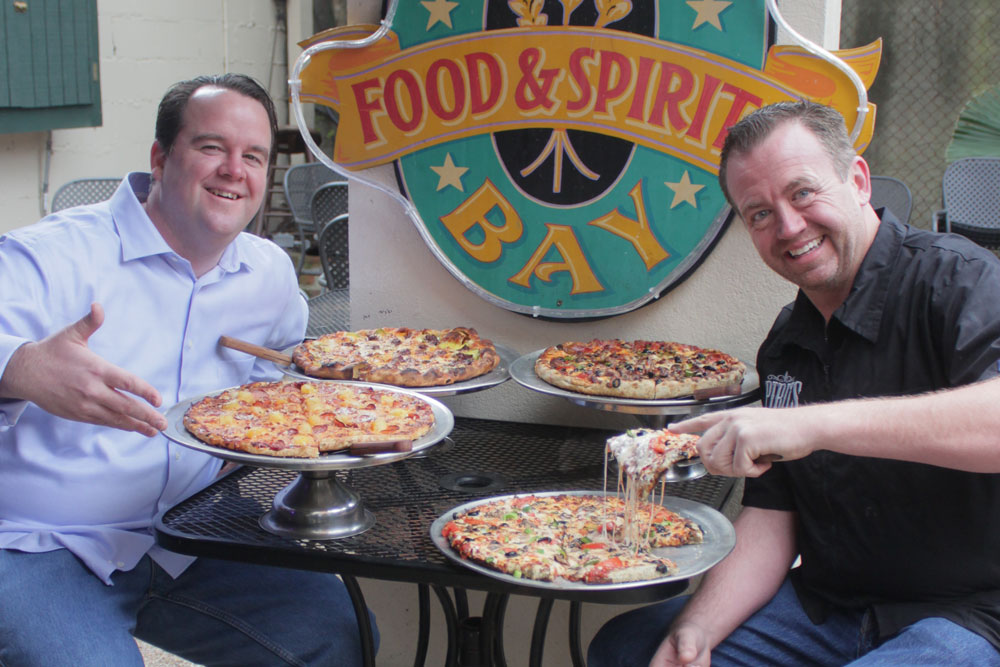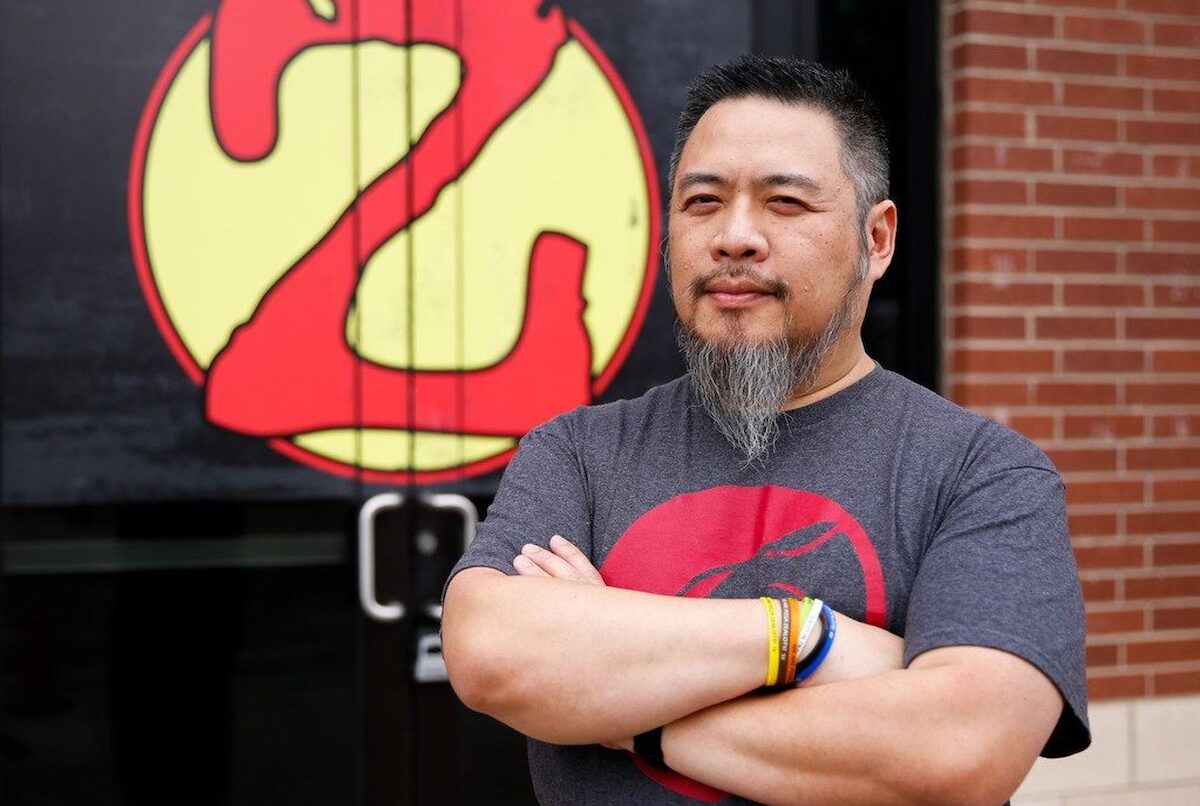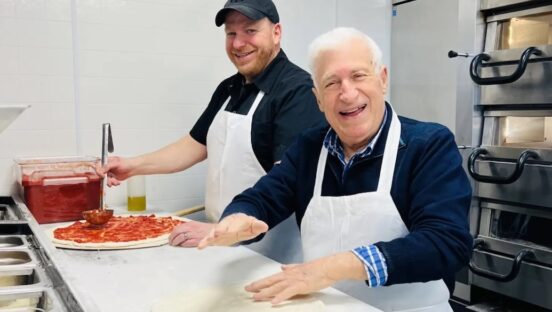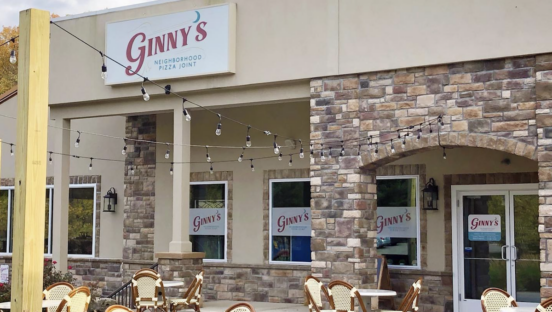In the wake of Hurricane Katrina in 2005, then-Speaker of the House Dennis Hastert made a bold proposition. Attempting to restore New Orleans—replete with poverty, corruption and racial division—to its original state “doesn’t make sense to me,” Hastert said, adding, “It looks like a lot of that place could be bulldozed.”
Hastert wasn’t the only one who felt that way. For months after the hurricane, pundits of all political stripes argued against rebuilding the “sunken city.” Fortunately, those who loved New Orleans weren’t listening. They were too busy hammering nails and repainting walls, bringing their ravaged hometown—warts and all—back to bustling life. And leading the way were enterprising pizzeria operators and chefs who set out to not only rebuild the city but to put their own unique spin on New Orleans cuisine.
On Freret Street alone, two pizzerias have helped transform a once-abandoned neighborhood into a trendy shopping and dining area. And other highly successful pizzerias have sprung up across the city, from the French Quarter to the Bywater District, spurring a renaissance that has revived the area while helping to preserve what makes New Orleans so special.
PMQ recently took a trip down to The Big Easy to check out the pizza scene and chat with many of the city’s top pizzaioli. What we discovered was a thriving culinary subculture that hasn’t been given its due—New Orleans isn’t just about gumbo and beignets anymore. And the city’s pizza boom mirrors a nationwide trend toward locally sourced ingredients, artisan styles, fast-casual convenience and even the use of crowdsourcing to finance a pizzaiolo’s dreams.
Turtle Bay: Saved by Bar Rescue
As the city’s most popular tourist destination, the French Quarter has come to symbolize the conviviality—and excess—of New Orleans. But Turtle Bay (turtlebayneworleans.com), a pizzeria on Decatur Street, has helped bring Italian traditions back to the district. “When we bought the place, it had been an Italian restaurant years before,” recalls Steve Smith, who co-owns Turtle Bay with Brad Bohannan. “We took some of what they did and tweaked it a bit. Not so many pizza places in New Orleans—especially in the French Quarter—make their own dough and make everything fresh.”
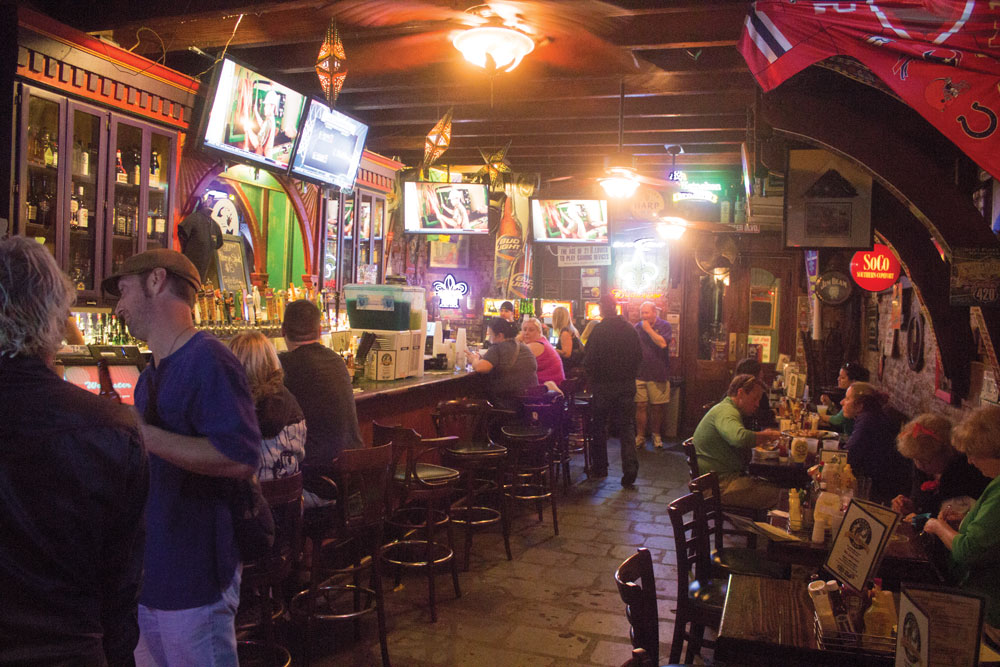 |
|
Located on Decatur Street in the heart of the French Quarter, Turtle Bay packs in bar patrons and hungry pizza fans 24 hours a day, seven days a week. |
Bohannan says he and Smith are pizza traditionalists. While seafood is the No. 1 natural resource locally, Turtle Bay offers only a few specialty pies with seafood, preferring to stick with the classics: a BBQ chicken pie, a cheeseburger pizza, a Hawaiian. They also serve a breakfast pizza—called the Hangover Helper—to soothe patrons surviving the dreaded morning after. Priced at $12.50 for a small and $18.50 for a large, this no-sauce pie features bacon, Canadian bacon, sausage, eggs, and mozzarella and cheddar cheeses.
“The key to success in any restaurant is consistency,” Bohannan notes. “In the French Quarter, [customers] are used to eating pizza at 3 a.m. I want to serve pizza that people will eat for lunch, dinner and supper.”
Open nightly through the wee hours, Turtle Bay is a popular spot for industry workers—its “dinner rush” comes at 4 or 5 a.m., when many servers in the area get off work at other restaurants—and also delivers to hotel rooms in the nearby area. Smith and Bohannan promote their delivery service with fliers and direct mail pieces and benefit from write-ups in area tourism guides.
Perhaps their most important PR break, however, came when a second Turtle Bay location, this one on Bourbon Street, was featured on Spike TV’s Bar Rescue last year. The show’s host, Jon Taffer, helped them to see that their clientele on Bourbon Street was different from the clientele just a few blocks away at the Decatur Street location. “People come to Bourbon Street for Cajun food,” Taffer says. “They don’t come 2,000 miles to eat a slice of pizza.”
Taffer convinced Smith and Bohannan to convert the Bourbon Street pizzeria into a bar, renamed Spirits On Bourbon, while re-energizing their pizza focus at the Decatur Street shop. On Decatur Street, Turtle Bay now focuses on affordable food that can feed entire families, which can be difficult to find in the French Quarter.
The lesson: Know your customers. “Pizza wasn’t right for [the Bourbon Street store],” Taffer says. “That’s why it’s now at Turtle Bay and not at Spirits. Their sales are up over $1 million since I left. That’s what spirits can do for your pizza operation if you do it effectively.”
Meanwhile, Smith and Bohannan keep working to make New Orleans a city that’s as famous for its pizza as for its late-night parties. “We want to get pizza’s reputation in the French Quarter back to where it should be,” Bohannan says. “It has a bad rep because every daiquiri shop sells pizza by the slice, and it hurts the reputation of operators like us. Our goal is to have good, fresh dough, fresh ingredients and consistency in everything we do.”
Ancora and Midway: Think Local
Only a block apart on Freret Street, Ancora Pizzeria & Salumeria (ancorapizza.com) and Midway Pizza (midwaypizzanola.com) have very different styles, but both attract a healthy mix of locals and tourists. For Jeff Talbot, a partner at Ancora, coming home to New Orleans after Katrina was important, but he felt nervous about bringing artisan Neapolitan-style pizza to Freret Street, a neighborhood formerly known largely for urban sprawl and white flight. “It was intimidating to start Ancora here because of the history of Freret Street,” Talbot says. “Three years ago, it was not the street it is now.”
After the post-Katrina floodwaters receded, a revitalization effort led to a Freret Street renaissance, and today restaurants can be found on nearly every block. Tourists and locals alike seek out Ancora—one of the city’s first Neapolitan-style pizzerias—for fine dining. To boost sales, each pizza on the menu is paired with a suggested wine selection, and appetizers range from the Anti Pizza Plate—which has a bit of everything, including meats from the salumeria—to bruschetta with burrata and beets, all presented with an artistic flair.
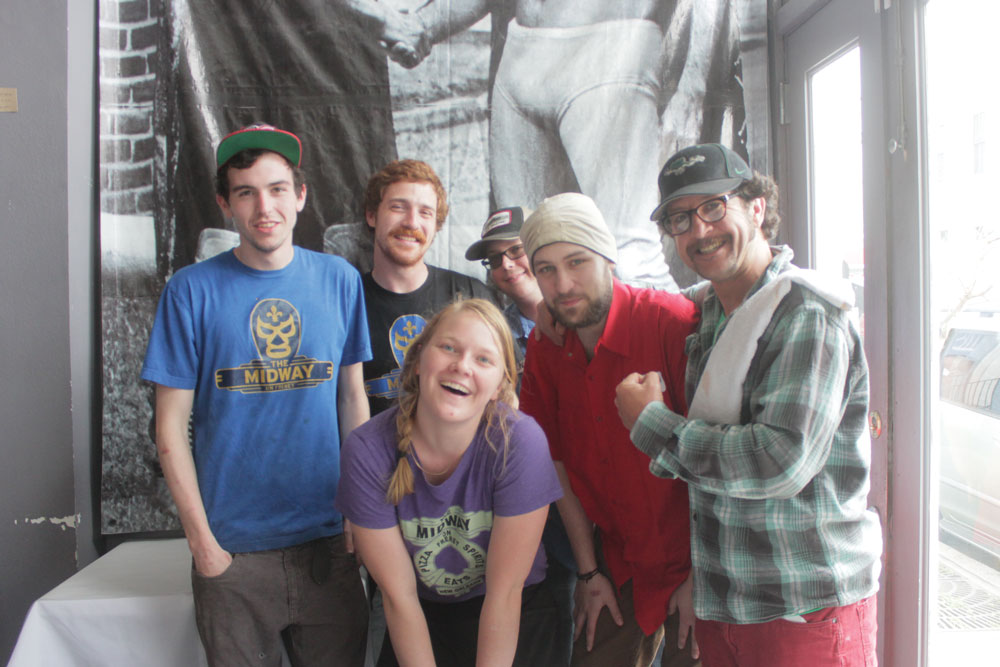 |
|
Steve Watson (far right) and his Midway crew serve up deep-dish pizza with a Big Easy twist |
To obtain all of the fresh local produce he needs, Talbot visits three farmers markets in New Orleans and a fourth on the North Shore each week. He also buys a pig every week from a local farm for his salumeria. “Throughout the country, there has been a push for small market farmers,” he says. “We are fortunate to have people around us who care about what they do.”
Down the street, Midway Pizza specializes in deep-dish pizza and is popular with both local families and students from Tulane University. Co-owner Steve Watson shares Talbot’s passion for pizza—his parents owned a pizzeria in Alexandria, Virginia, so he was born into the business.
Watson and his partner, Ben Sherman, both veteran bar operators, opened Midway Pizza on Freret Street in December 2010. “We lucked out because we were able to get the foundation of the pizza—the dough and the sauce—from my parents,” Watson says. “But we added some new ideas and character to our pizzas. We put a little twist on deep-dish pizza, adding a [touch of] New Orleans to it.”
So how does Midway Pizza stand out from the growing crowd of pizzerias in the city? For starters, it’s chock-full of folk art and boasts a unique theme inspired by Mexican wrestlers, or luchadores. The theme evolved organically over time, Watson notes. “We always seemed to have people giving us pictures of Mexican wrestlers, and we ended up creating a logo for the pizzeria with [that theme],” he says.
Watson and Sherman work with an advertising company and with the Freret Street Association’s own marketing team to build interest both in Midway Pizza and the district itself. The pizzeria has a solid Facebook presence, with 2,100 likes and regular posts featuring mouthwatering images of pizzas, salads and other menu items, plus promos for the Freretjet Lunch Special (all-you-can-eat deep-dish pizza and a salad for $8.99). “We have a media person who handles our online stuff,” Sherman notes. “We advertise online and find that it works, although there will never be a substitute for old-school fliers handed out with coupons. Still, everyone today has a mini-computer on his phone, so if you have a hankering for Midway food, we want you to find us online.”
Pizza Delicious: A Boost From Kickstarter
Native New Yorkers Greg Augarten and Michael Friedman, co-owners of Pizza Delicious (pizzadelicious.com) in the Bywater neighborhood, met in college in New Orleans and found that they both missed the pizza from their childhood. So they started creating their own recipes at home and eventually rented a shared space where they served pizzas to locals on Sundays. Word grew fast about the pop-up, and before long they couldn’t keep up with the orders. In November 2012, they opened their brick-and-mortar store, which was named one of the “38 Essential Pizzerias Across America” by Eater.com this year.
Popular with hipsters, locals and tourists alike, the pizzeria serves a range of New York-style pies, pastas and locally grown greens, including the popular Local Peach and Arugula salad. The menu changes daily with new specials and features a vegan option using nondairy cheese from Daiya.
Augarten and Friedman used Kickstarter to raise the funds for their Marsal & Sons oven. The crowdfunding approach isn’t just a new way to raise capital—it also helps a restaurant build a fan base before the first meal is served. Donors to Pizza Delicious received various perks, ranging from a social media thank-you for $5 to bumper stickers, T-shirts and other items for contributions of $10 to $50. Donors at the $125 level got their names on a thank-you plaque at the shop’s entrance. The partners’ fundraising goal was $15,000; they ended up netting $18,300.
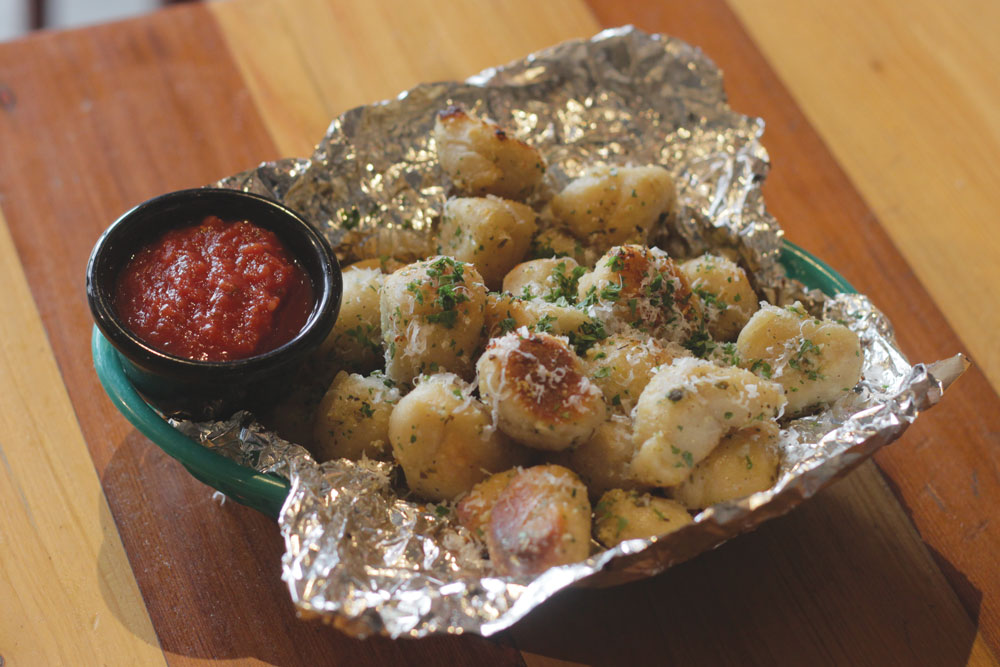 |
|
Pizza Delicious’ garlic knots have become a popular item, since only a few pizzerias serve them. |
Augarten and Friedman also buy local ingredients whenever possible and grow their own herbs. One of their biggest problems is keeping up with demand. “We keep the price point low so we can serve more people,” Friedman says. “We try to create an exclusive product, but there is only so much pizza, so we sell out every day.”
But the true testament to the success of Pizza Delicious comes when the partners’ friends from New York visit the restaurant. “Impressing people from where we grew up is the real test for us,” Friedman says.
Domenica: From Fine Dining to Fast-Casual
There are now two ways to try James Beard Award nominee Chef Alon Shaya’s pizza in New Orleans: the original Domenica (domenicarestaurant.com), which focuses on fine dining, and the newly opened Pizza domenica (pizzadomenica.com), a fast-casual eatery. Shaya moved to New Orleans in 2003 to work for chef John Besh, and the two later collaborated on Domenica, located in the historic Roosevelt Hotel just off Canal Street, in 2008. “John’s been a real mentor to me,” Shaya says. “We have a great partnership.”
Domenica has its own salumeria and serves wood-fired pizzas, handmade pastas and anything else the chefs can dream up using local ingredients. Area farms provide about 80% of the pizzeria’s vegetables, drawing farm-to-table fans by the throngs. “New Orleans influences our menu a lot,” Shaya says. “There is a beautiful range of resources here, from okra to kale to seafood. It would be counterproductive not to use all of it.”
With the new Pizza domenica, Shaya moved his pizza to Uptown, another fast-growing area with many new restaurants. Here, fast-casual is the big trend, Shaya says. “There are no reservations, and it’s about the neighborhood. We have a simpler menu but with more of a variety of pizzas. It is Domenica’s little sister, but this is not a cookie-cutter brand. It has a symbiotic relationship with the neighborhood. It is much more casual and has a lower price point.”
For Shaya, Italian food in New Orleans represents a return to the city’s roots. “There were more Italians in New Orleans than anywhere else in the country 120 years ago,” he notes. “Sicilians fled from Italy and came here. If you look at the produce and seafood companies, they have Italian names. There was a period of history, though, when they were ostracized here, and the tensions caused much of their history [in New Orleans] to be ignored. But now they are flourishing again.”
That’s part of the beauty of life in The Big Easy. Like many of the world’s great cities, New Orleans is truly a melting pot where men in business suits rub elbows with tattooed punks, panhandlers and jazz trumpeters—and everybody feels right at home. That’s why places like Turtle Bay can thrive and entrepreneurs like Bohannan and Smith can’t imagine living—or owning a pizzeria—anywhere else. “New Orleans is a place that accepts everything before it’s even popular,” Bohannan says. “It is a place in the world where titles don’t matter.”
For bonus coverage of the Big Easy’s pizza boom, visit our digital edition at pmq.com/digital. You can learn about Amici, another artisan pizzeria that has helped bring Italian pizza making tradition back to New Orleans, and watch a video on the Freret Street pizza scene.
| Pizza Underground Cheeses Up Some Classics in NOLA |
| You may think you’re a pizza fan, but unless you’ve started your own band just to sing about your love of pies, Pizza Underground—a comedy rock band co-founded by actor Macaulay Culkin—probably has you beat.
At a recent gig at the Hi-Ho Lounge in New Orleans, fans dressed up in pizza boxes and waited impatiently through two opening acts before the band finally took the stage. Partnering with local pizzeria Pizza Delicious, they gave out free pies during the sold-out show. One fan noted that she had just paid $20 to “watch the kid from Home Alone play a kazoo.” Pizza Underground, a takeoff on the legendary 1960s band The Velvet Underground, features Culkin and bandmates Phoebe Kreutz, Matt Colbourn, Deenah Vollmer and Austin Kilham. Turning Velvet Underground songs into pizza-themed covers, they first recorded a demo at Culkin’s home as a joke. “Femme Fatale” became “Pizza Gal,” while “All Tomorrow’s Parties” was parodied as “All the Pizza Parties.” Culkin even throws in a rousing kazoo solo on the Lou Reed-inspired “Take a Bite of the Wild Slice.” “I just discovered [the instrument] in the last couple of months and realized I am a natural kazoo player,” Culkin jokes. “Some people just got it. My mom is proud of me.” The band teamed up with a local pizzeria in every town during its spring tour. “We are genuine New Yorkers, and we liked [Pizza Delicious] a lot,” Culkin says. But Kilham singled out the Carmine Street location of Joe’s Pizza (joespizzanyc.com) in New York as their all-time favorite. “We met one of Lou Reed’s friends, and he assured us that Lou would have loved us and that Lou was also a Joe’s Pizza fan,” Kilham notes. “He would have been grumpy about it, though,” Kreutz adds. |



